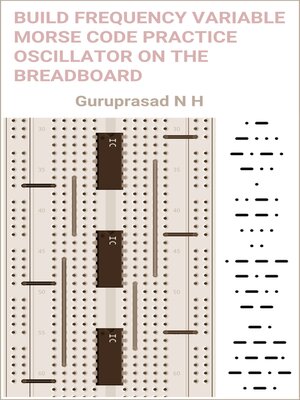BUILD FREQUENCY VARIABLE MORSE CODE PRACTICE OSCILLATOR ON THE BREADBOARD
ebook ∣ Project for Students, Hobbyists, and Electronics Enthusiasts
By Guruprasad N H

Sign up to save your library
With an OverDrive account, you can save your favorite libraries for at-a-glance information about availability. Find out more about OverDrive accounts.
Find this title in Libby, the library reading app by OverDrive.



Search for a digital library with this title
Title found at these libraries:
| Library Name | Distance |
|---|---|
| Loading... |
This eBook guides you to build a variable Morse code practice oscillator using timer IC 555.
The eBook is a dual benefit for you, can build an electronics project using timer IC 555 as well as you can practice Morse code!
American inventor Samuel F.B. Morse invented the code system in the United States of America during the 1830s for electrical telegraphy.
The initial version was further improved by Morse's assistant and partner, American scientist Alfred Lewis Vail.
A systematic arrangement of dots and dashes (dit and dah), and spaces uses for representing 26 letters of the alphabet, 0 to 9 numerals, and punctuation marks the Morse code.
The Morse codes we can transmit as electrical/electromagnetic pulses of varying lengths, or analogous mechanical or visual signals, such as flashing lights.
The Morse code practice oscillator circuit design is based on the popular timer IC 555, which is configured as an astable multivibrator.
The frequency output of the oscillator we can vary manually between 473.7 Hz to 1.38 kHz by using a potentiometer provided in the circuit.
The volume of the output to the speaker is manually adjustable by using a potentiometer provided in the circuit.
You have a choice to use either a momentary push switch or a commercially available Morse key for keying codes.
This book provides practical hands-on learning to experience to the amateur radio operators, engineers, technicians, students, and hobbyists who are curious and eager to learn and build projects on their own.
The chapters in the book explain all the relevant topics in a simple and descriptive manner for you.
Building electronics projects and practicing Morse code boosts your skills and analytic power to a great level. Thousands of applications have used them and they are popular.
This book includes Morse code charts, brief theory, calculations, circuit diagram, circuit description, parts list, breadboard wiring diagrams.
The book also includes actual photos of electronic components, pin diagram, and polarity, color code of components, and component value conversion tables.







